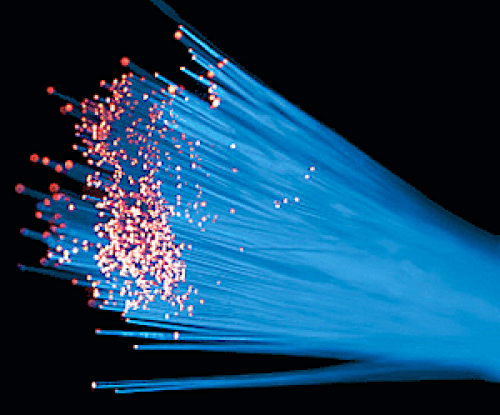
A new way to process fibre optic signals has been demonstrated by UCL researchers, which could double the distance at which data travels error-free through transoceanic sub-marine cables
The new method has the potential to reduce the costs of long-distance optical fibre communications as signals wouldn’t need to be electronically boosted on their journey, which is important when the cables are buried underground or at the bottom of the ocean.
As the technique can correct the transmitted data if they are corrupted or distorted on the journey, it could also help to increase the useful capacity of fibres. This is done right at the end of the link, at the receiver, without having to introduce new components within the link itself. Increasing capacity in this way is important as optical fibres carry 99% of all data and demand is rising with increased use of the internet, which can’t be matched by the fibres’ current capacity, and changing the receivers is far cheaper and easier than re-laying cables.
To cope with this increased demand, more information is being sent using the existing fibre infrastructure with different frequencies of light creating the data signals. The large number of light signals being sent can interact with each other and distort, causing the data to be received with errors.
The study, published in Scientific Reports today and sponsored by the EPSRC, reports a new way of improving the transmission distance, by undoing the interactions that occur between different optical channels as they travel side-by-side over an optical cable.
One of the biggest global challenges we face is how to maintain communications with demand for the Internet booming – overcoming the capacity limits of optical fibres cables is a large part of solving that problem.
Professor Polina Bayvel
Study author Dr Robert Maher (UCL Electronic & Electrical Engineering), said: “By eliminating the interactions between the optical channels, we are able to double the distance signals can be transmitted error-free, from 3190km to 5890km, which is the largest increase ever reported for this system architecture. The challenge is to devise a technique to simultaneously capture a group of optical channels, known as a super-channel, with a single receiver. This allows us to undo the distortion by sending the data channels back on a virtual digital journey at the same time.”
The researchers used a ‘16QAM super-channel’ made of a set of frequencies which could be coded using amplitude, phase and frequency to create a high-capacity optical signal. The super-channel was then detected using a high-speed super-receiver and new signal processing techniques developed by the team enabled the reception of all the channels together and without error. The researchers will now test their new method on denser super-channels commonly used in digital cable TV (64QAM), cable modems (256QAM) and Ethernet connections (1024QAM).
Learn more: New technique doubles the distance of optical fibre communications
The Latest on: Data transmission
[google_news title=”” keyword=”data transmission” num_posts=”10″ blurb_length=”0″ show_thumb=”left”]
via Google News
The Latest on: Data transmission
- Navigating the Future: Upgrading Networks in Data Centers for 400Gon April 26, 2024 at 4:30 am
Nicholas Cole, Data Center Solution Manager at EXFO, explains why the journey towards 400G and beyond is not merely about keeping pace but also ensuring that every step ...
- NASA's laser communications demo sends data from over 140 million miles awayon April 25, 2024 at 11:22 pm
NASA’s Deep Space Optical Communications (DSOC), an experiment riding aboard the agency's Psyche spacecraft, recently sent a copy of engineering data from over 140 million miles (226 million ...
- What are the key benefits of real-time monitoring of data transmission in mining operations?on April 25, 2024 at 2:09 pm
Most organisations are now reliant on their ability to transmit data about their daily activities and the mining industry is no exception. The demand for precious minerals, metals and resources ...
- Back From the Brink: NASA’s Voyager 1 Restores Data Transmission After 5 Monthson April 24, 2024 at 1:55 am
NASA's Voyager 1 spacecraft has begun transmitting usable engineering data for the first time since November after a chip failure in one of its onboard computers halted data transmission. For the ...
- Voyager 1 Resumes Data Transmission To Earth After 5-Month Hiatuson April 23, 2024 at 3:04 pm
NASA's Voyager 1 spacecraft sends decipherable data back to Earth after a five-month communication hiatus, marking a significant breakthrough for the mission.
- Effective data transmission through energy-efficient clustering and Fuzzy-Based IDS routing approach in WSNson April 17, 2024 at 9:13 am
Sensing systems are typically iterative, and have the same energy and capacity to perceive the environment through data calculation and transmission. An asymmetric radio relation is always found ...
- Researchers Achieve Record Data Transmission Speed, 4.5 Million Times Faster Than Average Home Broadbandon March 26, 2024 at 8:03 pm
According to the researchers, this remarkable accomplishment marks the fastest data transmission ever recorded. It was made possible by tapping into previously unused wavelength bands within fiber ...
- data transmissionon August 24, 2023 at 5:00 pm
It does have a few benefits though, including high rates of data transmission. In this system, [mircemk] is using an LED to send the information and a solar cell as the receiver. The LED is ...
via Bing News











